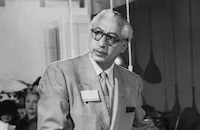Lord Byron of Broadway

Brief Synopsis
Cast & Crew
William Nigh
Charles Kaley
Ethelind Terry
Marion Shilling
Cliff Edwards
Gwen Lee
Film Details
Technical Specs

Synopsis
Roy, a cafe pianist and songwriter, uses his various romantic attachments as sources for creative inspiration, and when a girl who is infatuated with him shows him a bundle of old love letters, he exploits this material so successfully that he goes on to repeat the process with number of other girls. He finally stages his own vaudeville act with Nancy, a girl he discovers in a piano store. His friend Joe tries to save Roy from his habit of breaking hearts but himself dies as a result of his efforts. Consequently, Roy agrees to marry Nancy and give up his posture of a Broadway Lord Byron.

Cast
Charles Kaley
Ethelind Terry
Marion Shilling

Cliff Edwards

Gwen Lee

Benny Rubin
Drew Demarest
John Byron
Rita Flynn
Hazel Craven
Gino Corrado
Paulette Paquet
Crew
Louis Alter
Anne Bauchens
Nacio Herb Brown
David Cox
Raymond B. Egan
Arthur Freed
Cedric Gibbons
Joe Goodwin
Sammy Lee
Willard Mack
Willard Mack
Albertina Rasch
Henry Sharp
Douglas Shearer
Dimitri Tiomkin
Crane Wilbur
Crane Wilbur

Film Details
Technical Specs

Articles
Lord Byron of Broadway
Lord Byron of Broadway depicted the adventures of Roy (Charles Kaley), a songwriter out to use anyone who comes near him in his rise to the top. He turns the love letters written to his girlfriend into his first hit song, then dumps her for a singer who can help him up the ladder of success. He uses a a string of other women. When his best friend, Joe (Cliff Edwards), dies, all it means to him is the inspiration for a maudlin, chart-topping buddy song.
If audiences didn't exactly warm to this tale of showbiz chicanery, the fault lay not in the story, but in the stars. For despite the presence of experienced and popular players like Edwards, who had introduced "Singin' in the Rain" a year earlier in The Hollywood Revue of 1929, and Gwen Lee, who had been a fan favorite since the silent days, MGM trusted the leading roles to two singers straight from Broadway. Kaley and Ethelind Terry had been doing well as musical stars on the Great White Way, where she had recently played the title role in the hit Rio Rita, but when the cameras started running the magic simply wasn't there. Neither made more than a handful of films, and MGM quickly turned to more promising choices for singing stardom.
Despite the lackluster leads, there's still a great deal of interest in Lord Byron of Broadway. The Brown-Freed score produced its share of pleasing tunes, including one hit, "Should I?" For a ballet sequence, the music was provided by a recent Russian emigre who would go on to become a major Hollywood composer, Dimitri Tiomkin, the man behind the Oscar®-winning scores for High Noon (1952) and The High and the Mighty (1954). Look quick for Ann Dvorak as a chorus girl, appearing two years before she made history as Paul Muni's beloved sister in Scarface (1932). And if you listen closely when the characters play the radio, you'll recognize the unbilled voice of one of that medium's biggest comedy stars, Jack Benny, who also had a hugely successful television career.
Director: Harry Beaumont, William Nigh
Screenplay: Willard Mack, Crane Wilbur
Based on the novel by Nell Martin
Cinematography: Henry Sharp
Art Direction: Cedric Gibbons
Music: Nacio Herb Brown, Dimitri Tiomkin
Principal Cast: Charles Kaley (Roy), Ethelind Terry (Ardiaa), Marion Shilling (Nancy), Cliff Edwards (Joe), Gwen Lee (Bessie), Jack Benny (Voice on Radio), Ann Dvorak (Chorus Girl).
BW-78m.
By Frank Miller















